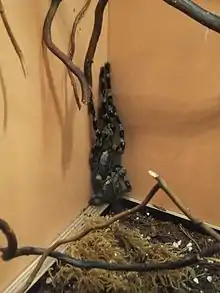| Yellow-backed ornamental tarantula | |
|---|---|
 | |
| Scientific classification | |
| Domain: | Eukaryota |
| Kingdom: | Animalia |
| Phylum: | Arthropoda |
| Subphylum: | Chelicerata |
| Class: | Arachnida |
| Order: | Araneae |
| Infraorder: | Mygalomorphae |
| Family: | Theraphosidae |
| Genus: | Poecilotheria |
| Species: | P. smithi |
| Binomial name | |
| Poecilotheria smithi Kirk, 1996[3] | |
| Synonyms[3] | |
| |
Poecilotheria smithi, or the yellow-backed ornamental, is a species of large arboreal tarantulas. It is endemic to Sri Lanka and considered to be critically endangered.[4]
Size
The female is much larger than male, with a head-to-body length of 6–7 cm. The figure for the male is 4–5 cm.
Identification
The species can be distinguished from other tiger spiders by all black leg parts (coxa, trochanter, femur) with prominent brushes on the femur.
Description
Female
Dorsally, the carapace is dark brown in color. The patella is greyish, the tibia is brownish black and the tarsus is brownish, with a v-shaped light patch proximally.[5]
Ventrally, the first and second leg pairs are identical. The coxa, femur and trochanter are all black, with a thin white distal band on the femur. The patella is white and the third and fourth leg pairs are identical.
Male
Dorsally, the spider is greenish brown. Folio markings are slightly darker. Ventrally, it is similar to female.[5]
Ecology
The yellow-backed ornamental is one of the rarest tiger spiders found on the island, where it is confined to the Haragama area in Kandy, with very few sightings from the region of Matale. It is highly restricted due to habitat destruction. The species is docile and not as aggressive as other tiger spiders. This makes it one of the popular pet spiders in the world.[5]
References
- ↑ The National Red List 2012 of Sri Lanka; Conservation Status of the Fauna and Flora. Vol. 8. Colombo, Sri Lanka: Ministry of Environment. p. 476.
- ↑ "Appendices | CITES". cites.org. Retrieved 2022-01-14.
- 1 2 "Taxon details Poecilotheria smithi Kirk, 1996". World Spider Catalog. Natural History Museum Bern. Retrieved 29 February 2016.
- ↑ Ranil P. Nanayakkara; Nilantha Vishvanath; T. G. Tharaka Kusuminda; G.A.S.M. Ganehiarachch (2013). "The Range Extension of the Critically Endangered, Poecilotheria smithi in Sri Lanka, with Notes on its Sociality". Asian Journal of Conservation Biology. 2 (1): 73–75.
- 1 2 3 Nanayakkara, Ranil P. (2014). Tiger Spiders Poecilotheria of Sri Lanka. Colombo: Biodiversity Secretariat, Ministry of Environmental & Renewable Energy. p. 167. ISBN 978-955-0033-58-4.
External links
